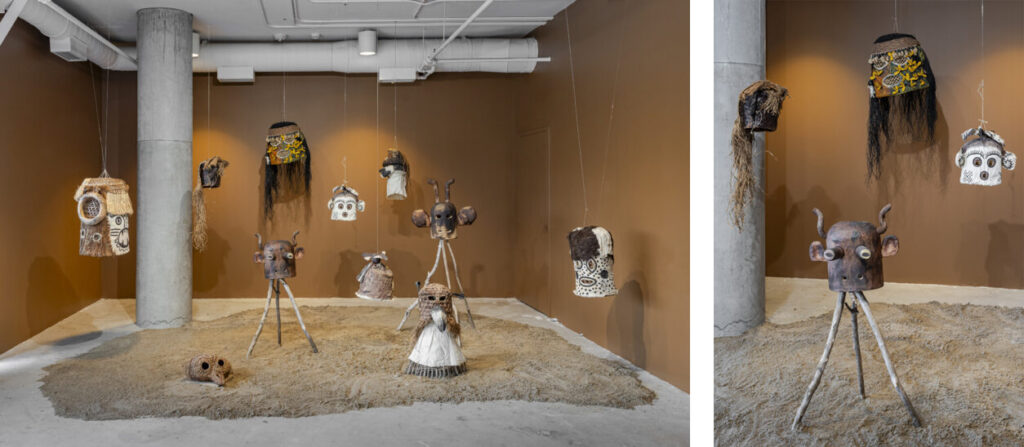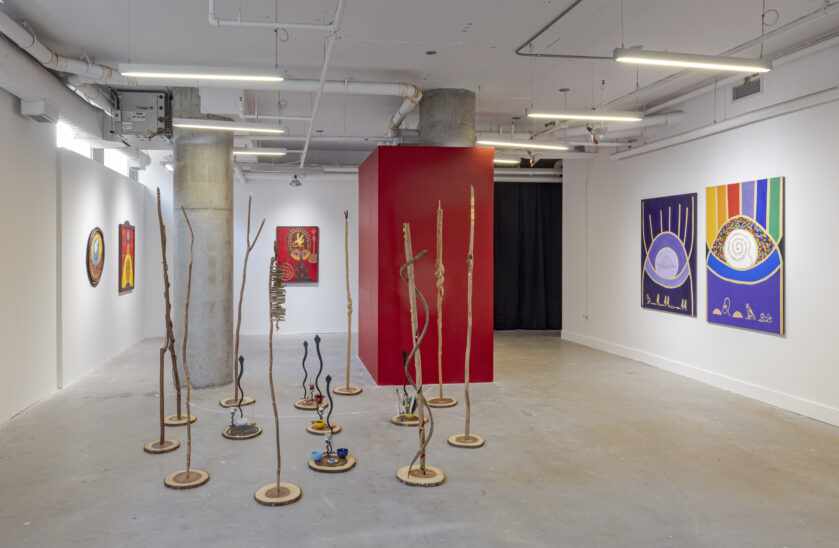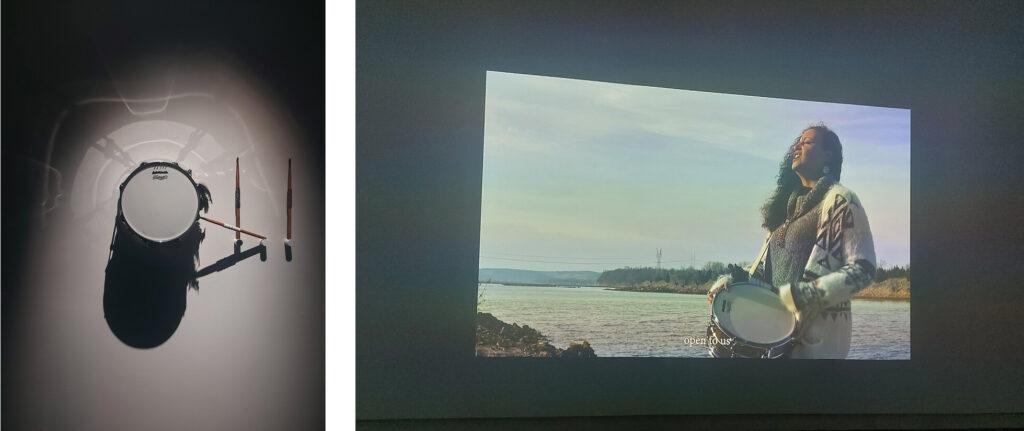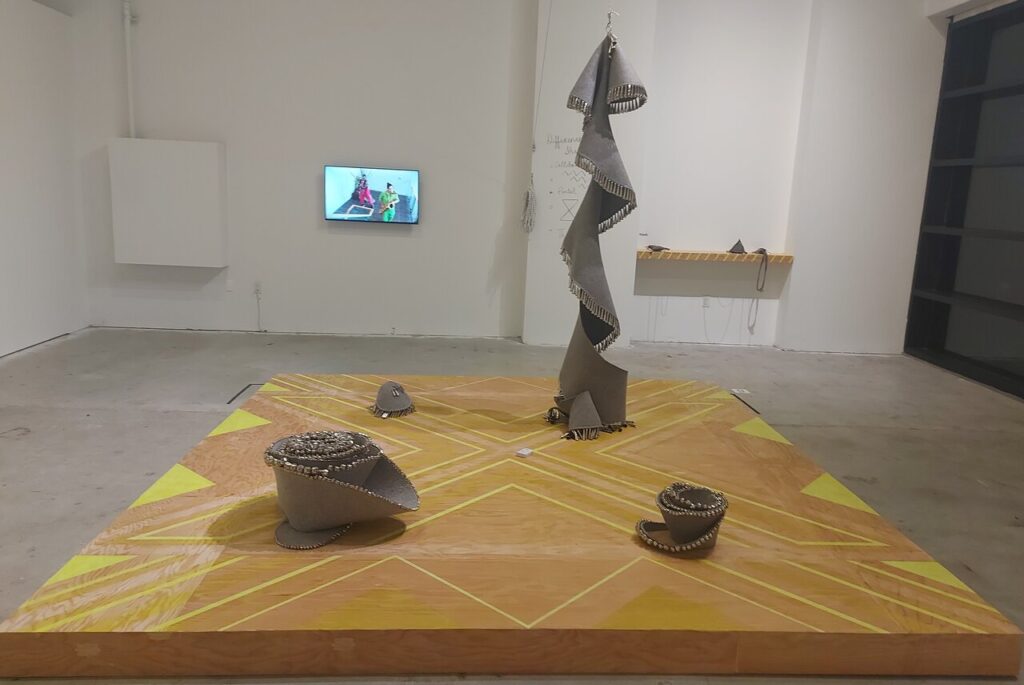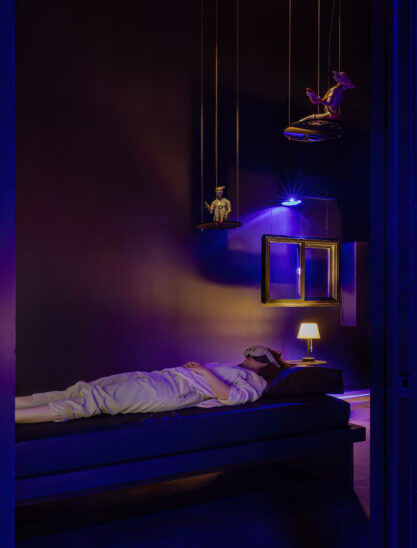32 Lisgar St. location
Climbing the stairs to the second floor, some hanging masks caught my eye and then I saw other masks in sand on the floor. A closer look at this installation revealed multiple mythological beings. They are Uitoto deities and spirits of the forest and river; reminders of the interweaving dimensions of spiritual and immaterial territories with the physical world. Artist Nereyda Lopez made traditional Uitoto masks from vegetal fibers and tree bark that she found in the forest. She named them “El luger de los espiritus’’ (The Place of Spirits). Her work honors Uitoto beliefs and confronts the current environmental destruction.
Nereyda López, El lugar de los espíritus (The Pace the Spirta) 2019 – 2023. Installation with eleven sculptures (left) and detail (right). Photo: Toni Hafkenscheid
There are many artworks on this floor that encouraged me to think about the ancient people, their ancestral wisdom and environmental consciousness. One of the highlighted artists is Winsom Winsom, whose work creates a bridge between the spiritual and terrestrial worlds through the use of visions, symbols and dreams, creating an alternative perspective. “Travelling Time”, a mixed media installation, that stands as the centerpiece of her section, explores themes of wisdom, transformation and ancestral heritage. On the floor, she installed nine wooden sticks with snake-like structures, accompanied by five ritualistic wooden boards with metal snakes. The nine branches symbolize life reaching upward. Number 9 is dedicated to the Goddess Oya. Metal snakes depict rebirth. “Travelling Time” symbolizes a sacred journey in the universe. Her paintings portray different symbols, such as spiders, snakes, and the color red, conveying profound meanings.
Winsom Winsom, Travelling Time, 2024, mixed media, 9 Magic Sticks, approx. 220 x 15 x 15 cm each. Courtesy of the artist and Clint Roenisch Gallery. Photo: Toni Hafkenscheid
“Scent of Thunderbolts”, a spectacular installation, based on a Cantonese opera performance stage, left me breathless. Walking through the bamboo fabric installation, I was fascinated by the photographs on the wall that offered glimpses into the rich history of Cantonese opera in Montreal. These images also reflected the Montreal Yuet Sing Cantonese Music Club’s significant role in preserving and promoting this art form. The photographs, spanning from the 1960s to the 2010s, captured opera artists, musical gatherings, and community celebrations.
Karen Tam, Scent of Thunderbolts, 2024, installation. Courtesy of the artist and Galerie Hugues Charbonneau, Montreal. Photo: Toni Hafkenscheid
A large section containing a hallway and a room, is transformed by immersive Indigenous art installations, sharing powerful stories of resistance, cultural heritage, and connection to the land. “Three Songs” is a three-channel video installation featuring Indigenous women singing in their native languages at historic sites of struggle.
Raven Chacon, Three Song, 2021, video installation, video stills. Photo: Nusrat Papia
“For Zitkála-Sá” honors First Nations composers through graphic scores. Nearby, “The Supernatural Powers of Fabulous Panther (Biimskojiwan)” sculpturally embodies Anishinaabe oral tradition, invoking the majestic miszhibizhiw through spiraling industrial felt and resonant jingles. Together, these works weave a narrative of resilience, preserving Indigenous culture and highlighting its ongoing relevance, from the Trail of Tears to the present day.
Maria Hupfield, The Supernatural Powers of Fabulous Panther (Biimskojiwan), 2024, Industrial felt, jingle bells, tin jingles, cotton fabric and polyester thread, Dimensions variable. Courtesy of the artist, Galerie Hugues Charbonneau, Montreal and Patel Brown, Toronto. Photo: Nusrat Papia
“She Who Sees the Unknown” left me profoundly moved, my heart heavy with the weight of intergenerational trauma and resilience. As a woman, I felt a deep connection to the narratives of sisterhood, motherhood, and lineage, woven through the artist’s childhood room, sculptures, and immersive VR film. The presence of the Right Witness and Left Witness, mythical jinn figures, served as reminders of the unseen forces that shape our lives. This 12-minute VR installation stands out as a must-see experience.
Morehshin Allahyari, She Who Sees the Unknown: Kabous, the Right Witness and The Left Witness, 2019, VR installation, Dimensions variable. Photo: Toni Hafkenscheid
The Toronto Biennial of Art, Lisgar St. location is a masterful curation of artistic expressions. Every piece inspires awe. Don’t miss this free, 10-week exhibition, running across 11 locations until December 1, 2024. This year’s theme, “Precarious Joy,” explores connections between art and social/ecological issues. Artists effectively tackle key issues like sovereignty, diasporic sonic culture, self-representation, belonging, migration, sacred plant wisdom, feminist genealogies, and queer worldmaking.
Nusrat Papia
*Exhibition information: Toronto Biennial of Art, September 21 – December 1, 2024, 11 locations in the city. 32 Lisgar St and Park, Toronto. Gallery hours: Tue–Thurs & Sat – Sun 10 am – 6 pm, Fri 10 am–8 pm. For TBA programming, please click here.

